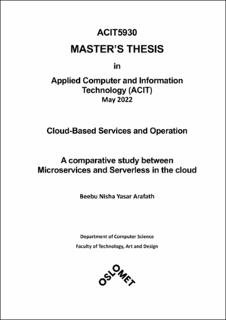A comparative study between Microservices and Serverless in the cloud
Abstract
The revolutionary transformation toward cloud computing microservices has gained rapid momentum among IT circles due to its agility, scalability, and resiliency. Many applications are deployed using microservices at their core to increase the agility and flexibility of management platforms. However, serverless computing has become a hot topic when deploying cloud-native applications. Compared to microservices, serverless architecture offloads management of underlying infrastructure and operational maintenance from the user to the cloud provider. Thus, the users focus only on building the business logic. With both these technologies, applications can take advantage of faster delivery, lightweight scalable, and lower development and maintenance costs. Hence, there are debates concerning which deployment strategy to use for their applications.
This thesis provides a comparison in terms of performance, cost, scalability, availability, security, stability, controllability, visibility, and development experience when deploying an application using microservices and serverless in two Cloud Platforms, AWS and Google cloud. Furthermore, the experimental results demonstrate the advantages and disadvantages of each type of deployment strategy under different scenarios and let the Organization decide and choose which deployment strategy to use. The microservice approach is best suited for predictable traffic, which results in better performance with pre-built instances. On the other hand, the large number of requests is handled by serverless due to its scaling agility and cost-effectiveness.
